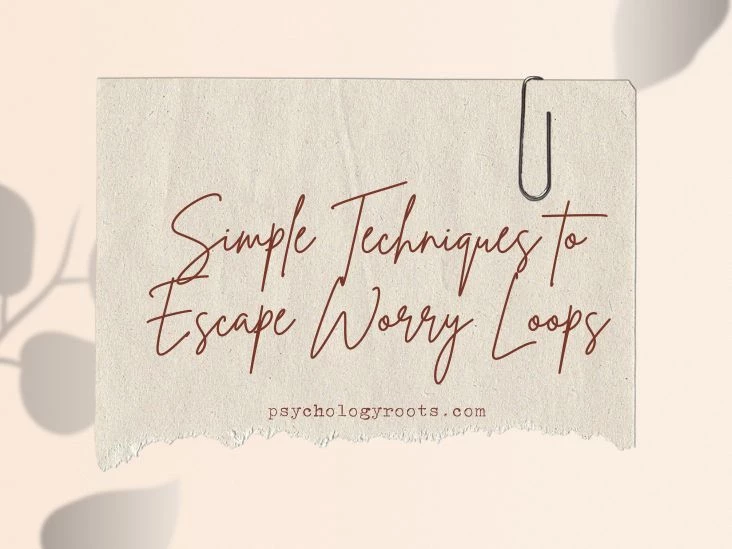Table of Contents
Simple Techniques to Escape Worry Loops
Here in this post, we are discussing “Simple Techniques to Escape Worry Loops”. You can read more about psychology-related material on our website. Keep visiting Psychology Roots.
When you are stuck in a worrying cycle, do you ever wish you knew how to get out of it? In other words, you’ve been there. Whether you’re in the shower, at your desk, or at the dinner table with your loved ones, chances are good that you’re thinking about something stressful like an impending deadline, an uncomfortable social situation, your money, etc. Even if you know that your anxiety is unfounded, or even that it is holding you back, it doesn’t help. You can’t seem to stop thinking about that one bothersome notion.
What’s that you say?
The good news is that there are three straightforward measures you can take, grounded in psychological science and neurobiology, to get off the worry-loop wheel and back to enjoying your life.

Start With a Breath Signal
In the 1970s, Dr. Bresler at UCLA created a method called the Signal Breath to help people relax by simultaneously releasing tension and signalling to the body that calm is on the way. Repetition of the Signal Breath causes the body to link stress relief with it and initiate the relaxation response on its own. Follow these steps to complete the task:
Notice the physical tension as you take a deep breath in and hold it. After 3–5 seconds, exhale softly while asking yourself to unwind. Do the steps again, but this time with much more emphasis. Follow the following step while continuing to breathe normally after you’ve taken your two Signal Breaths.
The Second Step: Pay Close Attention to Your Surroundings
Start with tuning your ears in to your immediate environment and then move on to the other senses. Focus your ears and pay close attention to everything you may hear around you. Let this be your only responsibility for the time being; the rest can wait.
Once you’ve mastered the sounds, it’s time to switch gears and concentrate on something visually. Take a close look at the object’s hue, surface, and design. Take careful note of everything you see so you may accurately explain it to someone else or recreate it in detail when you get home. After about a minute, it’s time to move on to the next sense—touch. Consider the warmth and the pressure your hands feel as you move your hand over the closest table or desk. Touch the upholstery of the seat you’re sitting on.
Notice the sensations in your body, such as the weight of your hands on your lap and the earth under your feet. Switch to using your nose after 30-60 seconds. Take a big breath in and focus on what you can smell around you, or go get a tea bag or some spices. Spend around 60 seconds sniffing about like a detective and trying to figure out what the odour is.
Plenty goes on when one’s senses are heightened in this way. In their seminal work from 2007, Farb and colleagues had volunteers do various mental tasks while being neuroimaged. It was shown that the narrative focus neural circuit was active while people were doing introspective, non-real-time activities. This route is critical for positive rumination like problem solving and planning, but it is also the site of negative ruminations like worry. As opposed to when participants were asked to think about the past or future, a different area of the brain, the experiential focus brain pathway, was active when participants were asked to pay attention to the here and now. More crucially for interrupting worry cycles, scientists found that a person could only be in one brain pathway at a time. Being fully present in the now is at odds with worrying about the future. A tried and true method of staying in the here and now is to practise heightened awareness of your immediate surroundings. This shifts your attention from the narrative focus brain route (which houses the anxiety loop) to the experiential focus pathway.
The Third Stage: Loving-In Action
The last phase consists of focusing on other people and giving them a piece of your heart and soul. Keep someone in your thoughts or prayers who is experiencing difficulty. Do an act of kindness or send a text message of encouragement. As a result, three goals will be met. First, it gives your mind a safe place to rest instead of travelling back to the source of your anxiety. Second, it reassures your brain’s threat centre, which is in charge of keeping you safe by letting you know when danger is present, that there is no immediate risk. If you’re actually in danger, you won’t worry about other people. The brain’s danger detector will pick up on this and dial back its alarms. Finally, if you’re feeling concerned or worried, doing an act of lovingkindness can help you feel better. The rewards of letting your true self shine through will make you feel good.
Help Us Improve This Article
Have you discovered an inaccuracy? We put out great effort to give accurate and scientifically trustworthy information to our readers. Please notify us if you discover any typographical or grammatical errors.
Make a comment. We acknowledge and appreciate your efforts.
If you have any scale or any material related to psychology kindly share it with us at psychologyroots@gmail.com. We help others on behalf of you.